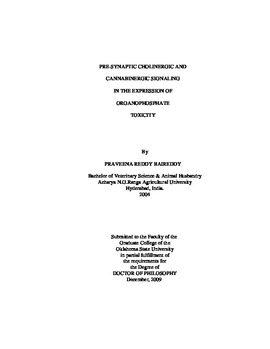| dc.contributor.advisor | Pope, Carey N. | |
| dc.contributor.author | Baireddy, Praveena Reddy | |
| dc.date.accessioned | 2013-11-26T08:35:12Z | |
| dc.date.available | 2013-11-26T08:35:12Z | |
| dc.date.issued | 2009-12 | |
| dc.identifier.uri | https://hdl.handle.net/11244/7649 | |
| dc.description.abstract | Scope and Method of Study: Organophosphorus toxicants (OPs) inhibit acetylcholinesterase (AChE) leading to acetylcholine (ACh) accumulation and cholinergic toxicity. The current approach for treating OP intoxication has several shortcomings, thus there continues to be a need for alternative treatment strategies. One approach could be to decrease ACh release from the pre-synaptic cholinergic terminal, potentially leading to less ACh accumulation and decreased signs of cholinergic toxicity. Activation of pre-synaptic muscarinic M2 and cannabinergic CB1 receptors can decrease ACh release. Pharmacological activation of these receptors could prove beneficial in OP poisoning. We hypothesized that genetic deletion of M2 and CB1 receptors would lead to loss of inhibitory control over ACh release and in turn increase cholinergic toxicity. We therefore systematically evaluated the sensitivity of M2 and CB1 receptor knockout mice to selected OP compounds in vivo. We also studied the effects of different OP compounds on ex vivo and in vitro ACh release in tissues from wildtype (WT), M2 and CB1 knockout (KO) mice. | |
| dc.description.abstract | Findings and Conclusions: Initial studies suggested that loss of either M2 or CB1 could affect sensitivity to OP toxicity. Surprisingly, both knockouts exhibited different degrees of AChE inhibition compared to the wildtypes, confounding interpretations. Subsequent studies using M2 +/+ and -/- littermates provided little evidence of altered sensitivity, however. Both WT and M2 KO showed tremors, a functional response considered to be mediated by M2 receptors, following exposure to parathion, suggesting non-muscarinic signaling in the expression of this sign of toxicity. ACh release following parathion exposure was not significantly different while paraoxon and chlorpyrifos oxon had differential effects on ACh release in vitro in tissues from WT and M2 KO mice. Similar to findings with M2 deletion, CB1 +/+ and -/- mice showed little difference in sensitivity to cholinergic toxicity following OP exposure. ACh release ex vivo was differentially affected following PS and CPF exposure in WT and CB1 KO mice, however. Paraoxon and chlorpyrifos oxon had differential effects on ACh release in hippocampal slices of WT and KO mice. Together, these findings suggest that presynaptic muscarinic M2 and cannabinergic CB1-mediated signaling pathways have relatively little influence on expression of cholinergic toxicity, but may influence neurochemical responses elicited by OPs that affect other neurobehavioral/neuropsychological consequences of intoxication. | |
| dc.format | application/pdf | |
| dc.language | en_US | |
| dc.rights | Copyright is held by the author who has granted the Oklahoma State University Library the non-exclusive right to share this material in its institutional repository. Contact Digital Library Services at lib-dls@okstate.edu or 405-744-9161 for the permission policy on the use, reproduction or distribution of this material. | |
| dc.title | Pre-synaptic cholinergic and cannabinergic signaling in the expression of organophosphate toxicity | |
| dc.contributor.committeeMember | Chen, Guangping | |
| dc.contributor.committeeMember | McFarlane, Diane | |
| dc.contributor.committeeMember | Wallance, David R. | |
| osu.filename | Baireddy_okstate_0664D_10718.pdf | |
| osu.accesstype | Open Access | |
| dc.type.genre | Dissertation | |
| dc.type.material | Text | |
| dc.subject.keywords | acetylcholine | |
| dc.subject.keywords | cannabinergic | |
| dc.subject.keywords | cb1 knockouts | |
| dc.subject.keywords | cholinergic | |
| dc.subject.keywords | m2 knockouts | |
| dc.subject.keywords | organophosphates | |
| thesis.degree.discipline | Veterinary Biomedical Sciences | |
| thesis.degree.grantor | Oklahoma State University | |
